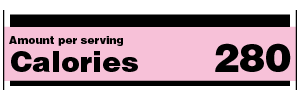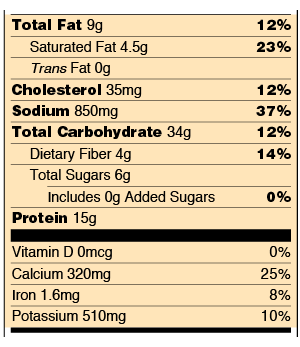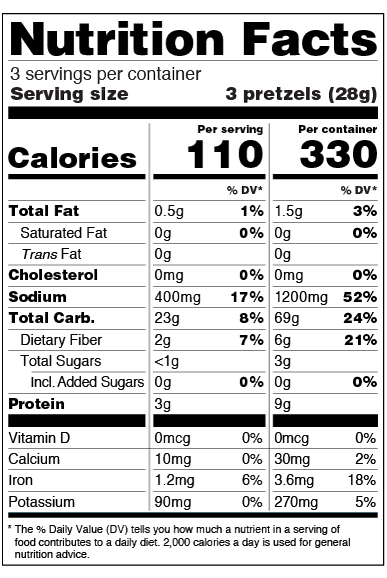Does A Food Service Director Have To Provide Carb Info On Lunch Menu
People look at food labels for a variety of reasons. Merely whatever the reason, many consumers would like to know how to apply this data more effectively and easily. The following label-reading skills are intended to get in easier for you to use the Nutrition Facts labels to brand quick, informed food decisions to help you choose a salubrious diet.
Overview | Serving Information | Calories | Nutrients | The Percent Daily Value (%DV) | Diet Facts Label Variations
For additional resources on the new Nutrition Facts label, visit www.fda.gov/NewNutritionFactsLabel.
Overview
The information in the principal or elevation section (run into #1-four) of the sample nutrition characterization (below) tin can vary with each nutrient and beverage production; it contains production-specific information (serving size, calories, and nutrient information). The bottom department contains a footnote that explains the % Daily Value and gives the number of calories used for general nutrition advice.
In the following Diet Facts label we take colored certain sections to assist you focus on those areas that volition be explained in detail. Note that these colored sections are not on the actual food labels of products yous buy.
Sample Label for Frozen Lasagna
back to pinnacle
one. Serving Data
(#1 on sample label)
When looking at the Diet Facts label, first take a look at the number of servings in the packet (servings per container) and the serving size. Serving sizes are standardized to make it easier to compare similar foods; they are provided in familiar units, such as cups or pieces, followed by the metric corporeality, e.g., the number of grams (g). The serving size reflects the corporeality that people typically swallow or drink. It is not a recommendation of how much you should eat or potable.
It's important to realize that all the nutrient amounts shown on the label, including the number of calories, refer to the size of the serving. Pay attention to the serving size, especially how many servings at that place are in the nutrient package. For example, yous might ask yourself if yous are consuming ½ serving, 1 serving, or more. In the sample label, one serving of lasagna equals 1 cup. If you ate two cups, you would be consuming two servings. That is two times the calories and nutrients shown in the sample label, then you would need to double the food and calorie amounts, as well as the %DVs, to run into what you are getting in two servings.
| Example | ||||
|---|---|---|---|---|
| One Serving of Lasagna | %DV | Two Serving of Lasagna | %DV | |
| Serving Size | 1 cup | 2 cups | ||
| Calories | 280 | 560 | ||
| Total Fat | 9g | 12% | 18g | 24% |
| Saturated Fatty | 4.5g | 23% | 9g | 46% |
| Trans Fat | 0g | 0g | ||
| Cholesterol | 35mg | 12% | 70mg | 24% |
| Sodium | 850mg | 37% | 1700mg | 74% |
| Total Sugar | 34g | 12% | 68g | 24% |
| Dietary Cobweb | 4g | 14% | 8g | 29% |
| Total Sugars | 6g | 12g | ||
| Added Sugars | 0g | 0% | 0g | 0% |
| Poly peptide | 15g | 30g | ||
| Vitamin D | 0mcg | 0% | 0mcg | 0% |
| Calcium | 320mg | 25% | 640mg | l% |
| Iron | ane.6mg | 8% | 3.2mg | 20% |
| Potassium | 510mg | 10% | 1020mg | 20% |
back to meridian
2. Calories
(#ii on sample label)
Calories provide a measure of how much energy you get from a serving of this food. In the example, there are 280 calories in 1 serving of lasagna. What if you ate the unabridged package? So, y'all would consume iv servings, or 1,120 calories.
To attain or maintain a good for you body weight, balance the number of calories you lot eat and drink with the number of calories your trunk uses. two,000 calories a day is used as a general guide for nutrition advice. Your calorie needs may be higher or lower and vary depending on your age, sex activity, height, weight, and concrete action level. Larn your estimated calorie needs at https://www.choosemyplate.gov/resources/MyPlatePlan.
Remember: The number of servings you lot consume determines the number of calories y'all really consume. Eating also many calories per day is linked to overweight and obesity.
back to top
3. Nutrients
(#iii on sample label)
Wait at section 3 in the sample characterization. Information technology shows you some key nutrients that impact your health. You can use the label to support your personal dietary needs – await for foods that incorporate more than of the nutrients you want to get more of and less of the nutrients you may want to limit.
- Nutrients to get less of: Saturated Fat, Sodium, and Added Sugars.
Saturated fatty, sodium, and added sugars are nutrients listed on the label that may exist associated with adverse wellness effects – and Americans by and large swallow likewise much of them, according to the recommended limits for these nutrients. They are identified every bit nutrients to get less of. Eating too much saturated fat and sodium, for example, is associated with an increased risk of developing some wellness conditions, like cardiovascular disease and high blood pressure. Consuming too much added sugars tin make information technology hard to see important nutrient needs while staying within calorie limits.
What are Added Sugars and How are they Dissimilar from Total Sugars?
Total Sugars on the Nutrition Facts label includes sugars naturally nowadays in many nutritious foods and beverages, such every bit sugar in milk and fruit as well as whatever added sugars that may be present in the product. No Daily Reference Value has been established for full sugars because no recommendation has been made for the total amount to swallow in a day.
Added Sugars on the Diet Facts label include sugars that are added during the processing of foods (such as sucrose or dextrose), foods packaged every bit sweeteners (such as table carbohydrate), sugars from syrups and honey, and sugars from concentrated fruit or vegetable juices. Diets high in calories from added sugars can make it hard to meet daily recommended levels of important nutrients while staying inside calorie limits.
Note: Having the give-and-take "includes" before Added Sugars on the characterization indicates that Added Sugars are included in the number of grams of Total Sugars in the product.
For example, a container of yogurt with added sweeteners, might list:
This ways that the production has 7 grams of Added Sugars and eight grams of naturally occurring sugars – for a total of xv grams of sugar.
- Nutrients to get more of: Dietary Fiber, Vitamin D, Calcium, Iron, and Potassium.
Dietary fiber, vitamin D, calcium, iron ad potassium are nutrients on the label that Americans generally practice non get the recommended amount of. They are identified as nutrients to get more of. Eating a diet high in dietary fiber can increase the frequency of bowel movements, lower blood glucose and cholesterol levels, and reduce calorie intake. Diets college in vitamin D, calcium, iron, and potassium can reduce the risk of developing osteoporosis, anemia, and high blood pressure.
Call up: Yous can use the label to back up your personal dietary needs—choose foods that incorporate more of the nutrients you desire to get more of and less of the nutrients you may want to limit.
back to summit
4. The Percentage Daily Value (%DV)
(#iv on sample label)
The % Daily Value (%DV) is the percentage of the Daily Value for each nutrient in a serving of the food. The Daily Values are reference amounts (expressed in grams, milligrams, or micrograms) of nutrients to consume or not to exceed each day.
The %DV shows how much a nutrient in a serving of a food contributes to a total daily nutrition.
The %DV helps you make up one's mind if a serving of food is high or low in a food.
Do you demand to know how to calculate percentages to utilize the %DV? No, because the label (the %DV) does the math for you! Information technology helps y'all translate the nutrient numbers (grams, milligrams, or micrograms) past putting them all on the same scale for the day (0-100%DV). The %DV column doesn't add up vertically to 100%. Instead, the %DV is the percentage of the Daily Value for each nutrient in a serving of the food. It can tell you if a serving of nutrient is high or depression in a nutrient and whether a serving of the nutrient contributes a lot, or a little, to your daily nutrition for each nutrient.
Notation: some nutrients on the Nutrition Facts characterization, like total sugars and trans fat, do not have a %DV – they will be discussed later.
General Guide to %DV
- 5% DV or less of a nutrient per serving is considered low
- 20% DV or more of a nutrient per serving is considered loftier
More often, cull foods that are:
- Higher in %DV for Dietary Fiber, Vitamin D, Calcium, Atomic number 26, and Potassium
- Lower in %DV for Saturated Fat, Sodium, and Added Sugars
Case: Await at the corporeality of sodium in one serving listed on the sample nutrition label. Is %DV of 37% contributing a lot or a little to your diet? Check the Full general Guide to %DV. This product contains 37% DV for sodium, which shows that this is a HIGH sodium product (it has more than 20% DV for sodium). If you consumed 2 servings, that would provide 74% of the DV for sodium – nearly three-quarters of an entire day'southward worth of sodium.
Compare Foods: Utilize %DV to compare nutrient products (call back to make certain the serving size is the same) and more often choose products that are college in nutrients y'all want to get more of and lower in nutrients y'all want to get less of.
Sympathize Nutrient Content Claims: Use %DV to help distinguish 1 merits from some other, such every bit "light," "depression," and "reduced." Just compare %DVs in each food product to see which one is higher or lower in a particular nutrient. There is no need to memorize definitions.
Dietary Trade-Offs: You can apply the %DV to assistance you make dietary merchandise-offs with other foods throughout the day. You don't have to give up a favorite food to eat a good for you diet. When a nutrient you like is high in saturated fatty, remainder it with foods that are low in saturated fat at other times of the 24-hour interval. Besides, pay attention to how much you eat during the entire day, so that the total amount of saturated fat, besides as other nutrients you want to limit, stays below 100%DV.
How the Daily Values Relate to the %DVs
Look at the example below for some other fashion to come across how the Daily Values (DVs) chronicle to the %DVs and dietary guidance. For each nutrient listed in the tabular array, there is a DV, a %DV, and dietary advice or a goal. If you follow this dietary advice, you lot will stay within public health experts' recommended upper or lower limits for the nutrients listed, based on a 2,000-calorie daily diet.
Examples of DVs versus %DVs
Based on a two,000 Calorie Diet
| Nutrient | DV | %DV | Goal |
|---|---|---|---|
| Saturated Fatty | 20g | =100% DV | Less than |
| Sodium | 2,300mg | =100% DV | Less than |
| Dietary Fiber | 28g | =100% DV | At least |
| Added Sugars | 50g | =100% DV | Less than |
| Vitamin D | 20mcg | =100% DV | At least |
| Calcium | 1,300mg | =100% DV | At least |
| Iron | 18mg | =100% DV | At least |
| Potassium | 4,700mg | =100% DV | At least |
Upper Limit - Eat "Less than"...
Upper limit ways information technology is recommended that you stay below or eat "less than" the Daily Value nutrient amounts listed per mean solar day. For instance, the DV for saturated fat is 20g. This amount is 100% DV for this nutrient. What is the goal or dietary advice? To swallow "less than" 20 g or 100%DV each day.
Lower Limit - Consume "At to the lowest degree"...
The DV for dietary fiber is 28g, which is 100% DV. This ways it is recommended that you eat "at to the lowest degree" this amount of dietary fiber on most days.
Nutrients Without a %DV: Trans Fats, Protein, and Full Sugars:
Note that Trans fatty and Total Sugars practice not list a %DV on the Nutrition Facts characterization. Poly peptide only lists a %DV in specific situations listed below.
Trans Fat: Experts could not provide a reference value for trans fatty nor any other information that FDA believes is sufficient to establish a Daily Value.
According to the Dietary Guidelines for Americans, there is evidence that diets higher in trans fatty are associated with increased blood levels of depression-density lipoprotein (LDL or "bad") cholesterol—which, in plough, are associated with an increased risk of developing cardiovascular disease. Note: most uses of artificial trans fatty in the U.S. nutrient supply have been phased out equally of 2018.
Protein: A %DV is required to be listed if a merits is fabricated for protein, such every bit "high in protein." The %DV for protein must also be listed on the characterization if the product is intended for infants and children under 4 years of age. All the same, if the production is intended for the general population 4 years of age and older and a claim is not made about protein on the label, the %DV for protein is not required.
Current scientific evidence indicates that protein intake is not a public health business organisation for adults and children over 4 years of age in the United States.
Total Sugars: No Daily Reference Value has been established for Full Sugars because no recommendations have been made for the total amount to consume in a day. Keep in heed that the Total Sugars listed on the Nutrition Facts label include naturally occurring sugars (like those in fruit and milk) as well as Added Sugars.
Diet Facts Label Variations
Many Diet Facts labels on the marketplace volition exist formatted in the aforementioned mode equally the lasagna label that has been used as an case throughout this page, but in that location are other formats of the label that food manufacturers are permitted to use. This final department volition present two alternate formats: the dual-cavalcade label and the single-ingredient sugar characterization.
In addition to dual-column labeling and single-ingredient sugar labels, there are other label formats which you can explore here.
Dual-Cavalcade Labels
For sure products that are larger than a single serving but that could be consumed in one sitting or multiple sittings, manufacturers volition have to provide "dual column" labels to bespeak the amounts of calories and nutrients on both a "per serving" and "per parcel" or "per unit" basis. The purpose of this type of dual-column labeling is to let people to easily identify how many calories and nutrients they are getting if they eat or drink the unabridged package/unit of measurement at one time. For case, a pocketbook of pretzels with three servings per container might take a characterization that looks like this to evidence y'all how many calories and other nutrients would be in one serving and in one packet (3 servings).
Pretzels
Unmarried-Ingredient Sugar labels
Packages and containers of products such as pure honey, pure maple syrup, or packages of pure saccharide are not required to include a declaration of the number of grams of Added Sugars in a serving of the product merely must notwithstanding include a declaration of the percent Daily Value for Added Sugars. Manufacturers are encouraged, but not required, to use the "†" symbol immediately post-obit the Added Sugars percent Daily Value on single-ingredient sugars, which would lead to a footnote explaining the amount of added sugars that one serving of the production contributes to the diet besides as the contribution of a serving of the product toward the percent Daily Value for Added Sugars. Single-ingredient sugars and syrups are labeled in this fashion so that it does not await like more than sugars have been added to the product and to ensure that consumers accept information about how a serving of these products contributes to the Daily Value for added sugars and to their total diet.
Here is an instance of how a label on a unmarried-ingredient sugar, such as honey, could await.
Honey
back to peak
Does A Food Service Director Have To Provide Carb Info On Lunch Menu,
Source: https://www.fda.gov/food/new-nutrition-facts-label/how-understand-and-use-nutrition-facts-label
Posted by: andersonwhishis.blogspot.com











0 Response to "Does A Food Service Director Have To Provide Carb Info On Lunch Menu"
Post a Comment